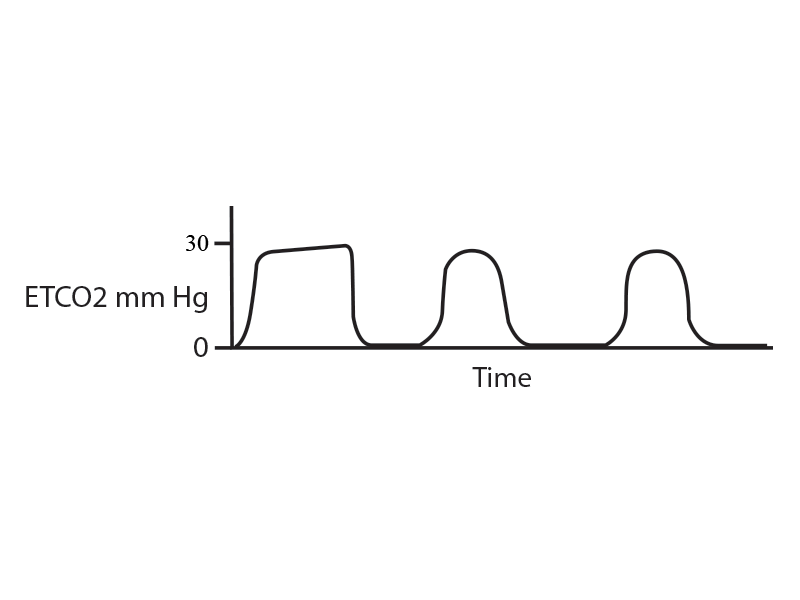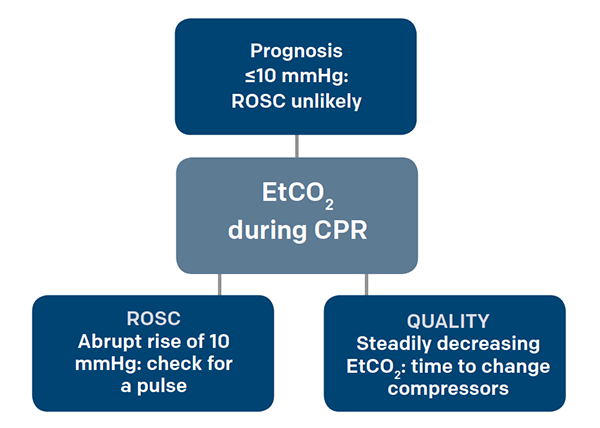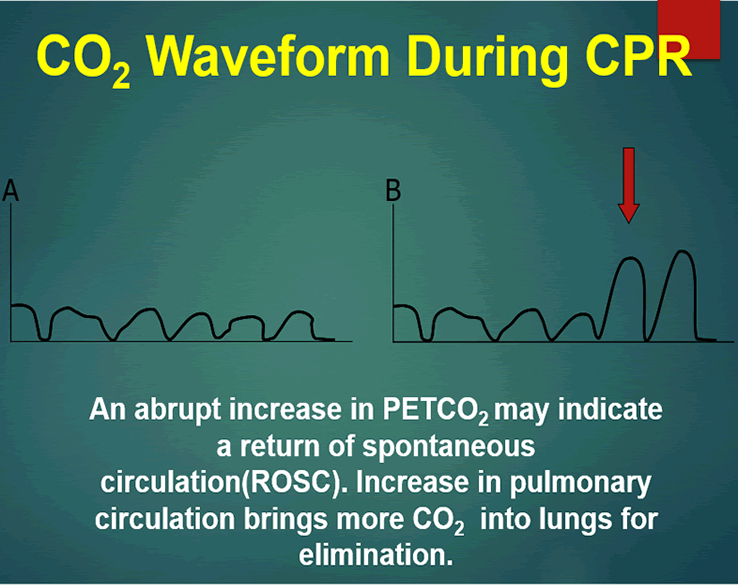low end tidal co2 during cpr
The normal values are 5 to 6 CO2 which is equivalent to 35-45 mmHg. End-tidal carbon dioxide ETco 2 monitoring provides valuable information about CO 2 production and clearance ventilation.

3 Waveform Capnography Showing Changes In The End Tidal Carbon Dioxide Download Scientific Diagram
Asphyxia was induced by clamping the endotracheal tube ETT and discontinuing ventilation.

. The data presented in this article are related to the research article The Use of End-Tidal Carbon Dioxide ETCO 2 Measurement to Guide Management of Cardiac Arrest. Pintado R Pérez Madueño V Díaz Monrové JC. MmHg Relate to the air we breath.
During CPR chest compressions along with positive pressure ventilation restore organ perfusion and oxygenation to some extent. NaHC03 will increase EtCO2 because it splits into CO2 and H20 So if rises after NaHCO3 do not misinterpret as ROSC. The height of the capnography waveform accompanies this number on the monitor as well as the.
Systematic review and meta-analysis of end-tidal carbon dioxide values associated with return of spontaneous circulation during cardiopulmonary resuscitation. Total pressure of a gas is the sum of the partial pressures of the gas Expired CO2 measured PetCO2 mmHg in waveform Percentage Normal Levels PaO2 85-100mmHg PaCO2 35-45mmHg Percentage vs. Crit Care Med 198513910-11.
39 Treveno RP Bisera J Weil MH Rackow EC Grundler WG. A low P a CO2 level is correlated with increased risk of cerebral edema in children with DKA. Ornato JP Garnett AR Glauser FL.
To identify whether any level of end-tidal carbon dioxide ETCO 2 measured during cardiopulmonary resuscitation CPR correlates with return of spontaneous circulation ROSC or survival in adults experiencing cardiac arrest in any setting. On the other hand a high CO2 reading may indicate airway narrowing. End-tidal CO2 ETCO2 detection requires air movement.
N Engl J Med. Here are five things you should know about waveform capnography in cardiac arrest. End-tidal CO2 EtCO2 is a noninvasive technique which represents the partial pressure or maximal concentration of CO2 at the end of exhalation.
Maslow A et al. J Intensive Care Med. On average during CPR if adequate chest compressions are being delivered a cardiac index of 16-19 Lminm2 can be generated which correlates with ETCO2 pressures of 20mmHg.
2001Monitoring end-tidal carbon dioxide during weaning from cardiopulmonary bypass in patients without significant lung disease. More Than Just a Number. Eleven intubated anesthetized paralyzed dogs mean age 41 mo.
11172009 4 Measuring End Tidal CO2 Daltons Law. In fact its commonly called the ventilation vital sign. Although the normal range for CO2 should be between 35-45mmHg CO2 monitoring gives healthcare providers a lot more insight into what is going on with a patients condition.
In mmHg the PetCO2 values for those with and without ROSC after five minutes of CPR was. Measurement of a low ETCO 2 value 10 mmHg during CPR in an intubated patient suggests that the quality of chest compressions needs improvement. The first sign of the return of spontaneous circulation ROSC during CPR is increase in ETCO2.
A low end-tidal CO2 may indicate poor perfusion hypovolemia or sepsis. We included randomized controlled trials cohort studies and case-control studies of adult cardiac. A study was undertaken to determine the pattern of end-tidal carbon dioxide ETCO2 changes during asphyxia-induced cardiac arrest in a pediatric canine model.
Non-invasive assessment of fluid responsiveness by changes in partial end-tidal CO2 pressure during a passive leg-raising maneuver. Mean weight 55 kg were used. What should end-tidal CO2 be during CPR.
423 20 mmHg versus 34 255 mmHg. Cardiac output and end-tidal carbon dioxide. A Systematic Review This article is a systematic review and meta-analysis of existing data on the subject of whether any level of end-tidal carbon dioxide ETCO 2 measured during.
End-tidal carbon dioxide cannot be used to rule out severe injury in patients meeting the criteria for trauma care. Levine RL Wayne MA Miller CC. 428 153 mmHg versus 323 141 mmHg.
End-tidal carbon dioxide concentration during cardiopulmonary resuscitation. Murphy RA Bobrow BJ Spaite DW et al. The amount of CO2 at the end of exhalation or end-tidal CO2 ETCO2 is normally 35-45 mm HG.
Free Full Text Critical Care. End-tidal carbon dioxide and outcome of out-of-hospital cardiac arrest. Falk JL Rackow EC Weil MH.
N Engl J Med 1988318607-11. Low etCO2 may be due to suboptimal CPR technique but it may also be due to death cessation of cellular respiration leading to a lack of CO2 production. Graphically this difference in ROSC vs non-ROSC PetCO2 for both groups appeared to be even greater at ten minutes.
Loss of ETCO2 may be the first sign that CPR is needed. Normal value is 35-45 mmHg. Abrupt increase in ETCO2 suggests ROSC during CPR detectable before pulse check ETCO2 at 20 minutes of CPR is prognostically useful.
Monitoring end-tidal carbon dioxide during weaning from cardiopulmonary bypass in patients without significant lung disease. End-tidal CO2 as a guide to successful cardiopulmonary resuscitation. Weil MH Bisera J Trevino RP Rackow EC.
1 ACLS guidelines define high quality chest compressions as. Association between prehospital cpr quality and end-tidal carbon dioxide levels in out-of-hospital cardiac arrest. Measurement of a low ETCO 2 value 10 mmHg during CPR in an intubated patient suggests that the quality of chest compressions needs improvement.
Carbon Dioxide During the Low Flow State Initiation of CPR. In the awake adult normal cardiac index lies between 25-4 Lminm2 with an ETCO2 of 35-45 mmHg. 78 Nitrogen 21 Oxygen 1 CO2 and other gases Exhaled gases.
Also called capnometry or capnography this noninvasive technique provides a breath-by-breath analysis and a continuous recording of ventilatory status. End Tidal CO 2 5 Continuous PETCO. Crit Care Med 198513907-9.
Throughout the resuscitation end-tidal CO 2 was consistently in the 28-36 mmHg range during VFCPR.
End Tidal Co2 The Drummer Of The Vital Sign Band Pem4

4 Things Paramedics Need To Know About Capnography And Heart Failure Capnoacademy Capnoacademy

Capnography Provides Bigger Physiological Picture To Maximize Patient Care Jems Ems Emergency Medical Services Training Paramedic Emt News

Etco2 Valuable Vital Sign To Assess Perfusion The Airway Jedi

Use End Tidal Capnography For Placing Orogastric Nasogastric Tubes And Cpr Page 2 Of 4 Acep Now Page 2

Waveform Capnography In The Intubated Patient Emcrit Project

Reversible Causes Of Low Etco2 In Cpr Criticalcarenow

The Impact Of Ventilation Rate On End Tidal Carbon Dioxide Level During Manual Cardiopulmonary Resuscitation Resuscitation
Emdocs Net Emergency Medicine Educationcapnography In The Ed Emdocs Net Emergency Medicine Education

Quantitative Waveform Capnography Acls Medical Training

3 Waveform Capnography Showing Changes In The End Tidal Carbon Dioxide Download Scientific Diagram

Reversible Causes Of Low Etco2 In Cpr Criticalcarenow

Capnography During Cardiopulmonary Resuscitation Current Evidence And Future Directions

Capnography Provides Bigger Physiological Picture To Maximize Patient Care Jems Ems Emergency Medical Services Training Paramedic Emt News

Average Etco2 Kpa During Cpr In Patients With Or Without Rosc Download Scientific Diagram

Waveform Capnography In The Intubated Patient Emcrit Project

Etco2 Valuable Vital Sign To Assess Perfusion The Airway Jedi

The Role Of Etco2 In Termination Of Resuscitation Jems Ems Emergency Medical Services Training Paramedic Emt News
